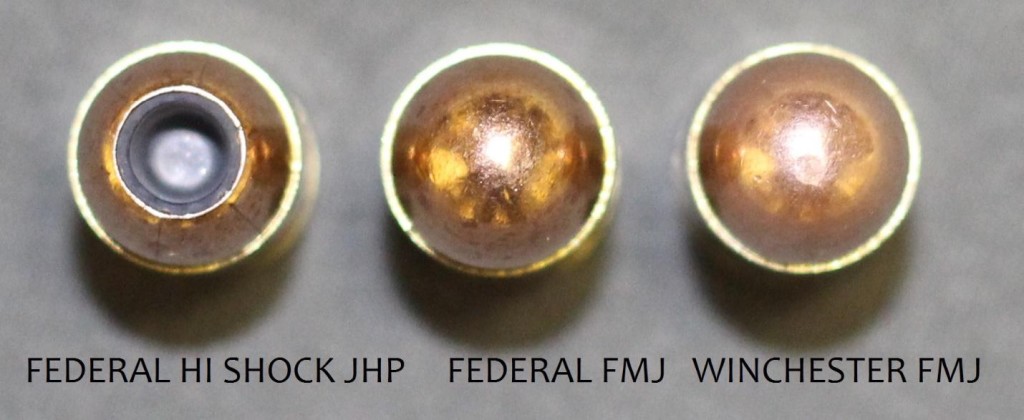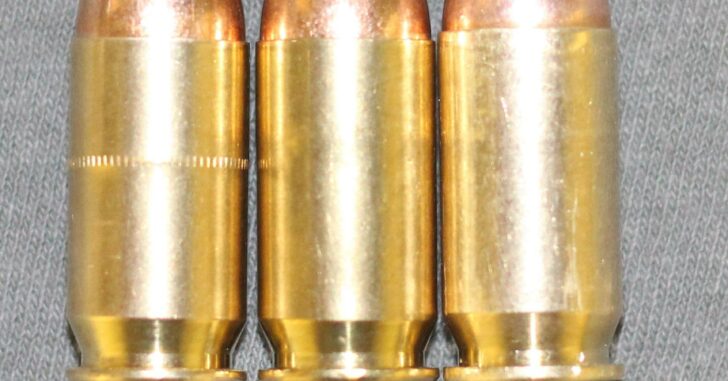This article describes a recent safety related situation from a factory loaded Winchester .45 Auto 230 Grain Full Metal Jacket (FMJ), and will emphasize why target ammunition in your Every Day Carry (EDC) is not advised. The article will also reinforce three safe gun handling rules for new owners.
I loaded my magazines with the Winchester FMJ on a typical range day. I was at about the 80th round in my session with my new Beretta PX4 Storm Special Duty; slow firing and trying to master the trigger pull and reset. I loaded the magazine, hit the slide release, and fired the first round with no issue. Feeling the trigger reset, I began to squeeze the trigger to fire the second round, when nothing happened.

My standard rounds for my Beretta PX4 Storm Special Duty 4
Baffled because the pistol had properly ejected the previous round and loaded a new one, I engaged the safety and removed the magazine. I noticed that the round did not seat properly in the barrel. Initially I thought the slow shooting could have caused this malfunction by “limp wristing” (when the grip and wrist is not firm enough to hold the frame of the pistol against the reward motion of the slide).

I reloaded the round and had the same malfunction, it would not seat properly in the barrel. I set the round aside, finished shooting the rest of the ammo, and decided to figure out the cause of the malfunction. Can you take a guess what the problem was?
Target Ammo: Expect what you pay for!
Gun owners that purchase ammunition from manufacturers expect a high quality product, for the cheapest price. But remember that old saying, ‘you get what you paid for’? This applies to ammunition as well. During the manufacturing process of ammunition, quality checks are conducted to ensure the ammunition will function properly. The checks can include:
1) Cartridge is correct (width, length, and free of any cracks, lumps, or bulges)
2) Correct stamp identifying what round it is
3) Correct primer is installed.
4) Correct amount of smokeless powder grains are loaded
5) Bullet (style, size and weight) are correct.
Manufacturers test random samples at the end of the process and allow a certain amount of failures to make it through, also known as an “acceptable failure rate”. Higher quality ammunition have lower acceptable failure rates. Quality ammunition will boast about having a 98-99% acceptance rate, which is pretty good. The most tested portion of the round is the primer, because it is a critical component to the ammo, as it initiates the explosive train, and ultimately determines if the round departs the cartridge and goes down range.
Since the round did not load properly into the barrel, I can eliminate the primer and gun powder as the cause of my malfunction.
My first guess: Caliber (width) was wrong, and either the casing was warped or bulged causing the cartridge to get stuck entering the barrel.

I lined up my .45 ammo next to each other as a comparison, and as you can see, there are no visible deformities in the width of the rounds (the Winchester on the right is the one in question). The bullet does looks correct, but you can notice the patina on the copper is a bit dull – identifying a lower quality copper.
When ammunition is mass produced, it is given a ‘lot’ number, identifying when and where the ammunition was produced. Lot numbers are assigned to each batch, so that if something is wrong with the ammunition, it is easier for the manufacturer to send out a recall message to the distributors and consumers. Each round that is produced in this process is known as a ‘factory load’. Anomalies occur in the production process, and a few rounds slip through that are not acceptable for use in a firearm.
 So what? Target ammo is meant for just that: Target practice. Expect failures in lower quality ammunition.
So what? Target ammo is meant for just that: Target practice. Expect failures in lower quality ammunition.
Continuing in the analysis and ruling out gun powder, primer, and casing width, I took a look at the actual casings. Can you spot the deformity that would cause a malfunction? The picture to the right is compared to an expended round from the same 100 Round Value Pack.
It can be extremely hard to identify the fault from a small profile picture that would be comparable to our eyesight, so here is a close up (click on image below for an even larger view):

Most of the time, you will not know that a round is bad until you try to fire it. Having never experienced this issue before in my years of shooting, I wanted to see how much of a difference in length would cause this malfunction.
Expended Round: Casing Length: 0.89”

Bad Round casing Length: 0.92”

The casing length is about .03” longer in this round.
I was surprised to experience this malfunction and have contacted the manufacturer to report the error. Here are a few tips you can use to identify bad factory loaded ammunition:
1) Visually inspect each round while loading into magazine. Look at the stamping (showing the size and manufacturer) and make sure it is the right size for your firearm.
2) Inspect the primer, casing, and bullet, and make sure there are no cracks or deformities in the casing or copper.
3) Feel the difference in size and weight for different calibers.
4) Check the manufacturers website to see if there have been any recalls to ammunition.
The also brings up some important safety rules related to ammunition that every new owner should be familiar with:
Rule #5: Use Correct ammunition.
The PX4 Storm is not my EDC, so I mostly cycle through the cheapest target ammunition I can find (Winchester 230 Grain 100 Value Packs), but occasionally practice with Hi-Shock. This is the correct ammunition for my firearm, but sometimes factory loads don’t work. Always check to make sure you are using the correct ammunition for your firearm.
Rule #6: If your Gun fails to fire when the trigger is pulled, handle with care!
During my years in the military firing hundreds of thousands of rounds, from .22 to .50, I’ve seen almost every malfunction, unsafe act, accidental discharge, etc. However, I have never experienced this particular incident with factory loaded ammunition. Knowing what to do in case of a malfunction is extremely important for your safety and others around you. If something happens and you are unsure what to do, always remember to follow safe procedures (keep it pointed in a safe direction), and unload the firearm in the safest manner possible before asking someone for help. If you are new to shooting and something happens, others may be willing to assist you as long as the firearm is unloaded and safe.
Rule #7: Learn the mechanical and handling characteristics of the firearm you are using.
Knowing what to do when your gun fails to fire is essential part of gun ownership. We should all be forever learners with firearms, and should always seek to expand our knowledge of safe shooting and shooting sports. After this incident, I now know how my Beretta will react if I come across another round like this.
What to do if you find bad ammunition:
First, safe your firearm! Most ranges will have an ‘Amnesty’ box, or a ‘Bad Rounds’ box. You may put it in there. You may also notify the manufacturer of the issue, they will want to know what happened and the lot number, so they can see if there were any trends with that particular lot. If your range has a Range Safety Officer, you can also notify them and give them the bad round.

